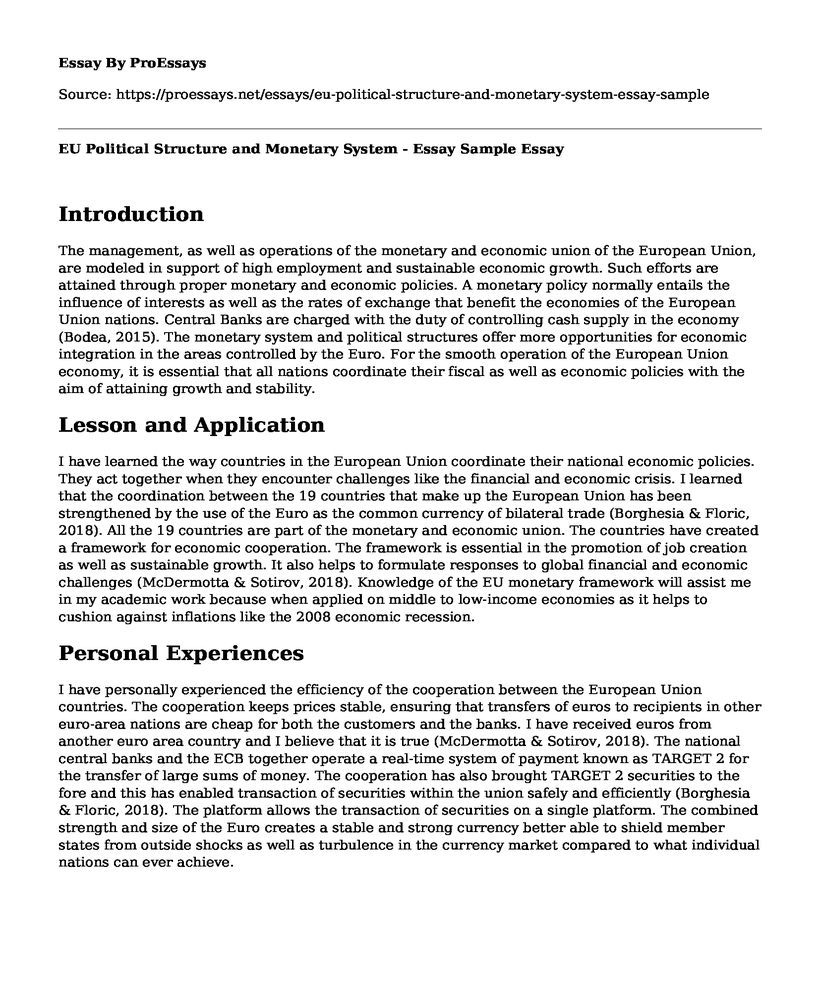Introduction
The management, as well as operations of the monetary and economic union of the European Union, are modeled in support of high employment and sustainable economic growth. Such efforts are attained through proper monetary and economic policies. A monetary policy normally entails the influence of interests as well as the rates of exchange that benefit the economies of the European Union nations. Central Banks are charged with the duty of controlling cash supply in the economy (Bodea, 2015). The monetary system and political structures offer more opportunities for economic integration in the areas controlled by the Euro. For the smooth operation of the European Union economy, it is essential that all nations coordinate their fiscal as well as economic policies with the aim of attaining growth and stability.
Lesson and Application
I have learned the way countries in the European Union coordinate their national economic policies. They act together when they encounter challenges like the financial and economic crisis. I learned that the coordination between the 19 countries that make up the European Union has been strengthened by the use of the Euro as the common currency of bilateral trade (Borghesia & Floric, 2018). All the 19 countries are part of the monetary and economic union. The countries have created a framework for economic cooperation. The framework is essential in the promotion of job creation as well as sustainable growth. It also helps to formulate responses to global financial and economic challenges (McDermotta & Sotirov, 2018). Knowledge of the EU monetary framework will assist me in my academic work because when applied on middle to low-income economies as it helps to cushion against inflations like the 2008 economic recession.
Personal Experiences
I have personally experienced the efficiency of the cooperation between the European Union countries. The cooperation keeps prices stable, ensuring that transfers of euros to recipients in other euro-area nations are cheap for both the customers and the banks. I have received euros from another euro area country and I believe that it is true (McDermotta & Sotirov, 2018). The national central banks and the ECB together operate a real-time system of payment known as TARGET 2 for the transfer of large sums of money. The cooperation has also brought TARGET 2 securities to the fore and this has enabled transaction of securities within the union safely and efficiently (Borghesia & Floric, 2018). The platform allows the transaction of securities on a single platform. The combined strength and size of the Euro creates a stable and strong currency better able to shield member states from outside shocks as well as turbulence in the currency market compared to what individual nations can ever achieve.
Experience and Prior Knowledge
Before interacting with the combined economic power of the European Union, I believed the cooperation was formed as a shield against economic recess and other similar financial crises. Contrary to my belief, the union does not operate as a normal central bank by creating job opportunities and improving the standards of living. Instead, it only deals with the capping of international EU nations currency differences and placing them at par with one another.
My experience according to the theory of Neo-functionalism sharply diverged from the ideals of the union in which the actions of the state were a result of the outcome of makers of political decisions. The theory asserts that the decision makers constantly had to cave into the pressures of their geopolitical environments. The theory described my experience because the actions of the union accrue from the result of the pressures. Practically, such pressures seldom lead to the required cooperation between the member states as well as other political alignments.
References
Bodea, C. (2015). Fixed exchange rates with escape clauses: The political determinants of the European Monetary System realignments. European Journal of Political Economy, 39(1), 25-40. doi.org/10.1016/j.ejpoleco.2015.03.007
Borghesia, S., & Floric, A. (2018). EU ETS facets in the net: Structure and evolution of the EU ETS network. Energy Economics, 75(1), 602-635. doi.org/10.1016/j.eneco.2018.08.026
McDermotta, C., & Sotirov, M. (2018). A political economy of the European Union's timber regulation: Which member states would, should or could support and implement EU rules on the import of illegal wood? Forest Policy and Economics, 90(1), 180-190. doi.org/10.1016/j.forpol.2017.12.015
Cite this page
EU Political Structure and Monetary System - Essay Sample. (2022, Dec 19). Retrieved from https://proessays.net/essays/eu-political-structure-and-monetary-system-essay-sample
If you are the original author of this essay and no longer wish to have it published on the ProEssays website, please click below to request its removal:
- Barrack Hussein Obama's Biography - Research Paper Example
- Treaty on the Non-Proliferation of Nuclear Weapons Essay
- Research Paper on LinkedIn Company
- Essay on AFL: An Organizational Solution to Employer-Worker Conflict in US History
- Office Environment: Key to Employee Happiness and Productivity - Report Example
- Essay Sample on Monopoly: Market Structure & Natural Resource Control
- Paper Example on NERs, RERs, Inflation: Understanding their Interactions







